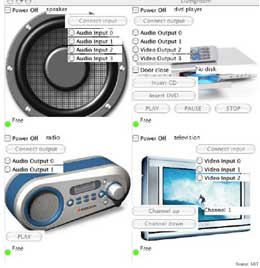The Roadie project, by Henry Lieberman and José Espinosa at the MIT Media Lab, redesigns the consumer electronics interface from a different angle, allowing novices and technophobes to configure and use combinations of devices. Instead of knobs and menu items for each function, the software presents the user with a list of goals — for example, record a movie on a DVD — and either automatically carries out the steps required to accomplish the task or guides the user through them.

Roadie consists of a user interface, a device interface, a database of commonsense knowledge (to help the system recognize that when you turn on the television you’re not intending to listen to the radio), and an AI-based task planner (to determine the individual steps needed to meet your goal.)
Roadie shows four control buttons:
• Perform this action will perform all the steps to accomplish the goal at once. If one of the actions needs the user’s manual intervention, the system will instruct the user
about what he or she needs to do.
• Instead of executing all the steps at once, Do next step executes them one step at a time. This permits the user to observe physical effects of each action.
• Tell me more explains why each step is important, how the user can perform the step, what can happen if the step is not finished, and how s/he can determine if the step has been performed correctly.
• Oops, it does not work! queries an online search engine for information about the step.
Roadie’s interface is currently deployed as a window on a computer screen, but it can be ported onto a PDA, a mobile phone or a Universal Remote Control.
A Goal-Oriented Interface to Consumer Electronics Using Planning and Commonsense Reasoning, Intelligent User Interfaces PDF.
Via Technology Research News.
